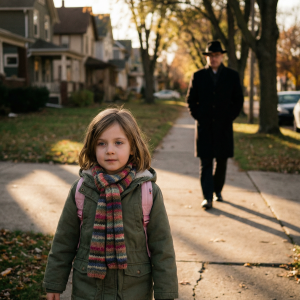The Addiction of Going Viral
Jake Chen’s phone buzzed incessantly, each notification delivering another hit of digital dopamine. At nineteen, he’d cracked the code that eluded millions of aspiring creators—turning outrageous stunts into cold, hard cash. His latest upload had shattered the two-million view barrier, and the comments section was a battlefield of laughing emojis and calls for his arrest. Perfect. Controversy was currency in the attention economy, and Jake was getting rich.
Hidden behind a dumpster at Sunset Community Garden, Jake methodically mixed theatrical blood from red paint and corn syrup. His mind wasn’t on algorithms or analytics—it was consumed by the intoxicating vision of his next viral explosion. This wouldn’t just be another prank. This would be his masterpiece.
For weeks, he’d been surveilling this particular target. The community garden was ideal: a heartwarming local initiative that would provide maximum dramatic contrast when he unleashed his carefully orchestrated chaos. The space buzzed with life—retired veterans who’d transformed abandoned wasteland into flourishing green rows, neighborhood children discovering the magic of growing their own food, elderly residents finding companionship among the tomato vines, and struggling families harvesting free vegetables to stretch their grocery budgets.
Jake’s scheme was devastatingly simple. He would orchestrate a fake environmental disaster—complete with professional hazmat gear, convincing chemical props, and enough theatrical terror to convince everyone that toxic waste had poisoned their beloved sanctuary. His audience devoured environmental scandals, especially those involving corporate villainy and government conspiracies. The fact that this contamination would be entirely manufactured was irrelevant to Jake. What mattered was raw, authentic panic. What mattered was going viral.
This elaborate deception represented months of escalating stunts. Jake’s content journey had begun innocuously—relatable observations about college dropout life, humorous takes on the creator economy grind. But wholesome content didn’t generate the explosive growth necessary for serious money. The watershed moment had arrived six months prior when Jake “accidentally” plunged into the downtown fountain, disrupting a wedding photoshoot. That video exploded overnight, garnering over a million views and earning more ad revenue than his previous six months combined. The bride’s furious comments only drove more traffic to his channel.
Since then, Jake’s pranks had grown progressively more elaborate and intrusive. Fabricated emergencies in crowded restaurants. Staged confrontations with security guards. Complex hoaxes that transformed innocent bystanders into unwitting performers in his content theater. Each successive video pushed ethical boundaries further, and each success reinforced Jake’s conviction that he was building something significant—a brand, an empire, a future that would vindicate everyone who’d ever doubted his potential.
The community garden represented his most ambitious undertaking yet. Jake had conducted weeks of reconnaissance, studying the veterans who managed the space, mapping peak visitor hours, purchasing professional-grade props, rehearsing his panicked delivery, and plotting camera angles that would capture both his “discovery” and the ensuing mayhem.
What Jake’s research had missed was the garden’s deeper significance. He knew veterans ran the operation, but he didn’t know that Vietnam veteran Robert Martinez had founded the project as therapy for his own PTSD while creating something transformative for his neighborhood. Jake was unaware that the garden supplied fresh produce to over forty food-insecure families, or that it served as a vital social hub for isolated elderly residents who might otherwise go days without meaningful human connection.
Most critically, Jake didn’t know that Robert Martinez’s grandson, eight-year-old Miguel, was celebrating his birthday in the garden that afternoon—a modest celebration for a child whose working parents couldn’t afford traditional party venues, but who’d spent months anticipating this special day with the friends he’d made while helping his grandfather tend vegetables.
Jake arrived at 2 PM, camera equipment concealed in his backpack, fake hazmat suit and chemical containers stashed behind a maintenance shed. The garden’s beauty caught him off guard—orderly vegetable rows, butterfly-attracting flowers, a cozy seating area where elderly visitors chatted while children darted between plant beds. For a fleeting moment, Jake experienced something resembling hesitation. These people radiated contentment, peace, genuine investment in something meaningful.
But the hesitation evaporated quickly. Jake had constructed his entire identity around being the creator who would attempt anything for content, who refused to be constrained by conventional morality or social expectations. His followers worshipped him precisely because he was fearless, because he crossed lines other creators wouldn’t dare approach. Retreating now would mean admitting he was ordinary, predictable, more concerned with others’ feelings than his own success.
The execution unfolded exactly as Jake had envisioned. Emerging from behind the shed in his hazmat costume, carrying official-looking containers branded with fake chemical company logos he’d designed, his voice carried perfect panic through the suit’s muffled mask as he began screaming about toxic contamination and immediate evacuation.
The response exceeded Jake’s wildest expectations. Children burst into tears. Elderly gardeners abandoned their tools, moving as rapidly as aging bodies permitted toward exits. Robert Martinez instantly assumed command, shepherding people away from the “contaminated” zone while maintaining calm authority despite obvious concern about Jake’s alarming claims.
Jake filmed everything, his phone camera capturing terror in faces, disruption of peaceful afternoon routines, transformation of community celebration into panic and confusion. In those moments, focused on securing perfect shots and delivering scripted lines about corporate environmental crimes, Jake felt the familiar adrenaline rush of successful content creation. This video would shatter records. This video would establish him as a creator brave enough to tackle serious issues others feared addressing.
Only when he glimpsed Miguel—still wearing his birthday hat, sobbing in his grandfather’s arms—did Jake feel his excitement momentarily crack. But even then, his primary concern wasn’t the child’s distress—it was whether the crying child would enhance his video’s emotional impact or cross platform moderation lines.
The performance continued for twenty minutes, with Jake maintaining his character as an environmental activist who’d uncovered evidence of illegal dumping during his independent investigation into corporate pollution. He’d researched enough legitimate environmental disasters to sound credible, and his apparent expertise convinced several community members the threat was genuine.
Robert Martinez finally unraveled the deception. Military service had taught him to maintain composure under pressure and notice details that contradicted obvious narratives. Jake’s chemical containers lacked authentic safety markings. The hazmat suit, convincing from distance, was clearly costume rather than actual protective equipment. Most tellingly, Jake’s phone remained constantly pointed outward, filming community reactions rather than documenting supposed contamination.
“Turn off the camera,” Robert said quietly, approaching Jake with the steady confidence of someone experienced in managing difficult situations. “Turn it off immediately.”
Jake, still performing, attempted to maintain his charade. “Sir, you must evacuate immediately. This area has been contaminated with industrial chemicals posing serious health risks—”
“I said turn off the camera.” Robert’s voice carried authority forged through years of life-and-death leadership. “This is my community. These are my friends and neighbors. And you’re filming their fear for your entertainment.”
The confrontation that followed lacked the dramatic escalation Jake’s content typically thrived on. Instead, it was characterized by Robert’s steady, disappointed composure as he methodically dismantled Jake’s hoax while community members realized they’d been manipulated for internet strangers’ entertainment.
Jake found himself in the unusual position of having his elaborate prank exposed not through dramatic confrontation but through the quiet dignity of people who refused to participate in the chaos he was attempting to create. Robert Martinez didn’t shout or threaten lawsuits. He simply asked Jake to leave, requested the footage not be posted without filmed individuals’ consent, and began reassuring community members that no actual environmental contamination had occurred.
But Jake’s investment in the project was too substantial to abandon. He’d spent weeks planning the video, purchased expensive props, and built anticipation among his followers about his next major project. The footage he’d captured was exactly what his audience craved—authentic reactions to dramatic situations, the kind of content that generated massive engagement and advertiser interest.
Despite his better judgment and Robert Martinez’s explicit request, Jake posted the video three days later. He edited out the confrontation where his hoax was exposed, instead ending at peak panic with a dramatic call-to-action about environmental awareness and corporate accountability. In his description, he framed the entire incident as a “social experiment” designed to raise awareness about real environmental threats facing urban communities.
The response was immediate and overwhelming. Within six hours, the video gained 500,000 views and trended across multiple platforms. Jake’s subscriber count jumped by 50,000 overnight. Comments flooded in praising his courage for addressing environmental issues and creativity in finding innovative awareness-raising methods.
But buried among the praise were different voices—messages from people who recognized the community garden, who knew Robert Martinez and understood what the space meant to the neighborhood. These commenters provided context Jake’s edited video had deliberately omitted, explaining that the “corporate contamination” had been entirely fabricated and real people had been genuinely terrorized by Jake’s performance.
Local news stations picked up the story, but not as Jake expected. Instead of covering environmental contamination at the community garden, they reported on a “social media hoax” that had caused unnecessary panic among elderly residents and children. Coverage included interviews with Robert Martinez and several community members describing their experience as unwilling participants in content created for someone else’s profit.
Jake’s initial instinct was doubling down on his environmental awareness narrative, but as more context about the community garden emerged, his justification became increasingly unsustainable. Social media users began researching the garden’s history, sharing stories about how it served food-insecure families and provided social connection for isolated elderly residents. Photos of Miguel’s disrupted birthday party circulated online, accompanied by criticism of content creators who prioritized viral fame over community wellbeing.
The controversy should have been manageable. Jake had weathered criticism before, and negative attention still generated views and engagement. But something different occurred this time—instead of the usual outrage cycle followed by gradual forgetting, the story continued growing as community members and local organizations began using Jake’s video as an example of harmful content creation that exploited vulnerable populations for entertainment.
The tipping point arrived when Robert Martinez was interviewed by local television about Jake’s hoax impact on the community garden. The interview was conducted in the garden itself, with Miguel helping his grandfather tend vegetables while discussing how the fake emergency had frightened him and ruined his birthday celebration.
“This isn’t merely about one video or one young man making poor choices,” Robert said during the interview, his weathered hands gently guiding Miguel in watering tomato plants. “This is about a culture that rewards people for harming others, that treats real communities and real people as raw material for entertainment content. We’ve built something beautiful here, something that helps people and brings joy to children like my grandson. When someone transforms that into a source of fear and confusion for their own benefit, we all lose something precious.”
The interview went viral independently, but with different energy than Jake’s original video. Instead of celebrating disruption and chaos, it highlighted positive work being done by the community garden and real impact Jake’s hoax had on people’s lives. Comments on the interview praised Robert Martinez’s dignity and community leadership while criticizing the broader prank content culture that rewarded creators for causing innocent people distress.
Jake watched his subscriber count decline for the first time since beginning viral content creation. Brands previously interested in sponsorship deals suddenly stopped responding to emails. Platform algorithms that had previously boosted his content began suppressing it in response to increasing harmful behavior reports.
More troubling than immediate financial consequences was Jake’s growing isolation from his own community. Friends and classmates initially impressed by his online success began distancing themselves as the story spread. His parents, who had been cautiously proud of his entrepreneurial success, expressed disappointment and concern about his content’s direction.
The crisis deepened when Jake received a message from the platform’s content moderation team informing him that his community garden video had been demonetized and his account was under review for community guidelines violations related to harmful pranks and misinformation. For the first time since beginning content creation, Jake faced the possibility that his entire online career might be destroyed by a single video.
Desperately, Jake decided to create a response video addressing the controversy. His plan was apologizing for any harm caused while maintaining that his intentions had been raising environmental awareness. He would position himself as a young creator who’d made mistakes but was committed to learning and growing from the experience.
But as Jake sat before his camera trying to craft an apology that would satisfy critics without alienating remaining supporters, he found himself unable to articulate why his actions had been justified. The more he thought about Miguel’s frightened face and Robert Martinez’s disappointed dignity, the more hollow his environmental activism narrative sounded, even to himself.
The apology video Jake eventually posted was awkward and unconvincing, caught between genuine remorse and self-preservation instincts. He admitted his methods had been flawed while still claiming positive intentions. Audience response was mixed—some supporters appreciated his willingness to address the controversy, but many criticized the apology as insufficient and self-serving.
More importantly, the apology did nothing to repair actual damage Jake had caused to the community garden and people who depended on it. Several elderly community members stopped visiting the garden, still concerned about potential contamination despite reassurances that Jake’s hoax had been completely fabricated. Families with children became more cautious about participating in garden activities, worried about becoming targets for future pranks or hoaxes.
This realization—that his pursuit of viral fame had caused lasting harm to people who’d done nothing except try to create something positive in their community—finally broke through Jake’s defensive rationalization about his content creation methods.
Three weeks after his apology video, Jake drove to the community garden with no camera equipment, no content creation agenda, and no plan beyond trying to understand what he’d actually done to these people. He found Robert Martinez working alone in early morning, tending vegetable plots with methodical care of someone for whom the work was meditative rather than merely functional.
“I wasn’t sure you’d return,” Robert said without looking up from tomato plants he was staking. “But I hoped you would.”
The conversation that followed lasted three hours and changed Jake’s life trajectory in ways he couldn’t have anticipated. Robert Martinez didn’t lecture him about his video’s harm or demand additional apologies. Instead, he talked about the garden’s history, his own journey from traumatized veteran to community leader, the satisfaction of building something that helped other people.
“You have skills,” Robert told Jake as they worked together repairing fence damage that had been neglected since the hoax disrupted normal garden maintenance. “You understand technology, you can tell stories, you can capture people’s attention. The question is what you want to do with those skills. You can continue using them to tear things down, or you can learn to build something up.”
Over following months, Jake began spending mornings at the community garden, initially just helping with maintenance and learning sustainable gardening practices. Robert Martinez didn’t ask him to stop creating content, but challenged Jake to consider what kind of content might actually serve his community rather than exploiting it.
Slowly, Jake began experimenting with a different content creation approach. Instead of elaborate hoaxes and disruptive pranks, he started documenting real work being done by community organizations like the garden. His videos became quieter, more thoughtful, focused on highlighting people who were solving problems rather than creating chaos.
The transition wasn’t easy. Jake’s new content generated fewer views and less dramatic engagement than his previous work. Many original followers drifted away, bored by videos about community gardening and local environmental initiatives. Potential sponsors were less interested in associating with content that didn’t promise viral reach and explosive engagement.
But something unexpected began happening as Jake continued producing community-focused content. The viewers who remained were more engaged, more likely to take action based on what they saw, more interested in meaningful conversation than simple entertainment. Local organizations began reaching out to Jake, asking him to document their work and help them reach new audiences.
Most importantly, Jake discovered that creating content that helped other people achieve their goals was more satisfying than anything he’d experienced during his viral fame period. When his video about the community garden’s food distribution program resulted in dozens of new volunteers signing up to help, when his documentation of a local environmental cleanup inspired viewers to organize similar events in their own communities, Jake felt a sense of purpose that no amount of views or subscriber growth had ever provided.
The transformation wasn’t immediate or complete. Jake continued struggling with financial realities of creating positive content that didn’t generate massive engagement numbers attracting advertisers. He had moments of doubt wondering if he’d been naive to abandon controversial content that had been so financially successful.
But Robert Martinez’s mentorship provided stability during Jake’s transition period. The older man had seen enough young people struggle with finding direction to understand that genuine change required patience and consistent support rather than dramatic interventions.
“Building something worthwhile takes time,” Robert reminded Jake during one of their morning conversations while tending the garden’s herb section. “Tearing things down is quick and gets attention, but it doesn’t leave anything useful behind. When you build something, it lasts. It helps other people build their own things. That’s how real change happens.”
A year after his disastrous community garden hoax, Jake’s content creation career looked completely different. His subscriber count had stabilized at about half his peak numbers, but audience engagement was higher and more meaningful. He’d developed partnerships with local environmental organizations, community development nonprofits, and educational institutions that valued his ability to make their work accessible to younger audiences.
More importantly, Jake had become a genuine advocate for responsible content creation, speaking at digital literacy workshops and creator conferences about the difference between content that exploited communities and content that served them. His story became a case study in how viral fame built on harmful behavior was ultimately unsustainable, while content focused on community service could provide both personal fulfillment and professional success.
The community garden thrived, with Jake’s positive coverage helping attract new volunteers and donors who supported expanded programming. Miguel, now nine years old, had become one of Jake’s most trusted collaborators, offering content suggestions and helping ensure videos accurately represented the community’s needs and goals.
On the one-year anniversary of his hoax video, Jake created a documentary about the community garden’s impact on neighborhood food security, featuring interviews with families who depended on the garden’s produce and volunteers who found purpose in tending shared spaces. The video was his most successful in terms of real-world impact, generating donations, volunteer signups, and media attention that supported the garden’s expansion into adjacent lots.
But the most meaningful response came from Robert Martinez himself, who watched the documentary with tears in his eyes before telling Jake, “This is what your skills were meant for. This is how you honor the platform you’ve been given.”
As Jake looked around the thriving garden—children learning plant biology while grandparents shared stories of their own childhood gardens, families harvesting vegetables for dinner, teenagers who’d learned video production skills by helping document the space—he understood what Robert had been trying to teach him about the difference between building and destroying.
The views on his positive content might not reach the millions his hoax video had generated, but they represented something more valuable: genuine connection, real impact, and the kind of legacy that would outlast any viral moment. Jake had learned that true influence wasn’t measured by how many people watched you, but by how many people were better off because you’d used your platform responsibly.
Years later, when young content creators asked Jake for advice about building sustainable careers in digital media, he would tell them about the morning he stood in Robert Martinez’s garden, watching an elderly veteran teach his grandson to plant seeds, and finally understanding that the best content didn’t just capture attention—it planted seeds of its own, growing into something that enriched the communities it touched rather than exploiting them for entertainment.
The real transformation, Jake had learned, wasn’t just about changing his content creation methods. It was about changing his definition of success from individual achievement to community impact, from viral fame to meaningful contribution, from taking from the world to giving back to it in ways that would continue growing long after the cameras stopped rolling.





